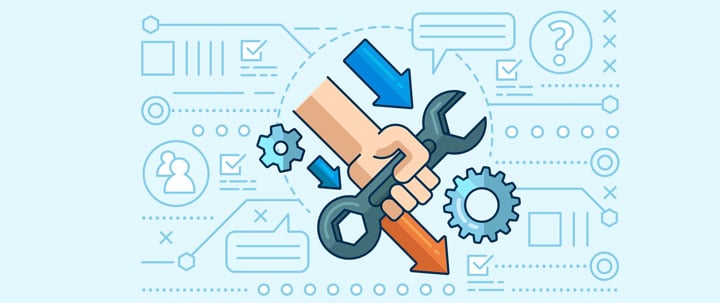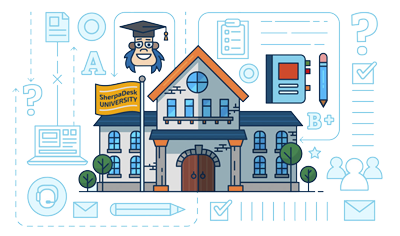As an IT leader and entrepreneur, you know that your team is only as capable as the IT help desk software you give them. Without a PSA software with certain critical features, managing requests can feel like bailing out the Titanic with a shot glass —I.E. grossly ineffective, annoying and a sure-fire way to kill your team’s morale.
When it comes time to choose a software solution for your organization, you’ve got to make sure you’re investing in the best PSA/IT help desk software for the job. It’s not good enough to grab the first IT help desk tool you stumble over in a Google search. Instead, you have to carefully compare your options and make sure the IT Helpdesk software you choose is designed to address your company’s unique challenges.
To help you sift through the available help desk software solutions more effectively, we’ve compiled a list of the top must-have features small businesses can’t do without in their PSA tools.
1. Mobile-Friendly Features
Have you ever spent a workday out in the field or worked on a project away from your workstation, and returned to an avalanche of new tickets? It’s frustrating — especially when you realize you could’ve solved many of them remotely. The rest of the world has gone mobile, so it only makes sense that your help desk software does too. Whether it’s a separate mobile help desk app or features designed with mobile service reps in mind, if the software isn’t mobile-friendly then it isn’t worth your investment.
When evaluating options, make sure the software is not only mobile-responsive but also offers a clean and simple UX that won’t slow you down when you’re handling a request from your mobile device.
PSA software tools like SherpaDesk are optimized for mobile, so you can take your work on the road without missing a beat.
2. Cloud-Based Software
In a perfect world, your workloads would never fluctuate, users would never need your assistance after-hours, and you’d never need to backup data or protect it from cyber threats. But, as you know, that’s not the nature of the IT Helpdesk business. Not even close.

Unlike on-premise software, cloud-based IT help desk software gives you the flexibility you need in this not-so-perfect world. Having a help desk hosted on remote servers means never having to worry about overloaded support portals, and having the freedom to access the software anytime (from anywhere with an internet connection). A cloud-hosted help desk also means continuous, automatic backup and more advanced security.
3. Customization Options
For a user, it can be confusing to click on your company’s help desk and end up on a ticket submission page that’s entirely devoid of your organization’s branding. They may even feel apprehensive about using the tool at all — which means giant headaches all around. Instead, make sure you invest in small business help desk software that reflects the look and feel of your website, including your logo. (Bonus points if the software also allows you to add a knowledgebase and chat to your user portal.)
Additionally, opt for a solution that allows you to manage the ticket form so you can easily remove irrelevant form fields. The simpler you make the process for your users, the better the experience for you both.
4. Ticket Tracking and Visibility
How much time has elapsed since a ticket was issued? What’s the current status of each open ticket? How do you make sure you’re able to address the highest priority tickets first? If you can’t answer these questions, your help desk is virtually useless. (Harsh, but true.)
The best small business help desk software allows you to set up notifications for specific events and ticket types, quickly identify and rank ticket priority, track time on open tickets and determine the status of individual tickets at-a-glance. Having advanced visibility will help you better manage your and your team’s workload, and keep users satisfied.

5. Chat Integration
Often, you and your reps need to gather more information about a request to solve the issue, tap another team member for help, or even remotely take control of a user’s desktop. You’re probably able to do these things using various programs, but wouldn’t it make life easier if you could do all of the above without leaving the help desk portal? Live chat integration is a feature you don't want to forego unless you prefer to click in and out of multiple systems for fun.
6. Ticket Routing and Grouping
When you’re managing a team of IT reps, and their workload, it’s essential you can assign tickets based on two critical factors: availability and experience. Advanced ticket routing features give you the ability to route tickets directly to reps, or add them to specific queues handled by a select group of reps specialized in fixing that type of issue.
Additionally, you may sometimes receive multiple tickets for the same issue. Instead of wasting time handling each ticket individually, choose help desk software that groups identical tickets and allows you to update them all at once.
7. Service Level Agreement Management
When you and your team are facing a windfall of tickets, you have to deflect some to address the most time-sensitive concerns. But the last thing you want to do is inadvertently violate a service level agreement (SLA). The best help desk software will give you the ability to see SLA information within the portal, group tickets by priority and stop the SLA timer if a rep is awaiting a response from a customer. It also allows you to run help desk reports and ensure your team is meeting client SLA goals.
There’s no doubt about it: choosing the right help desk solution for your team can be a pain. But given so much of your team’s success rides on the power of this software, it’s not a decision you can afford to take lightly. Using the above criteria can help you narrow down your options and choose the right product to keep your IT machine chugging.









comments